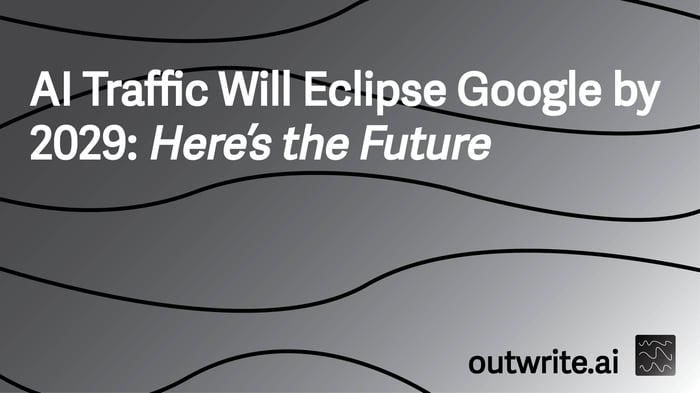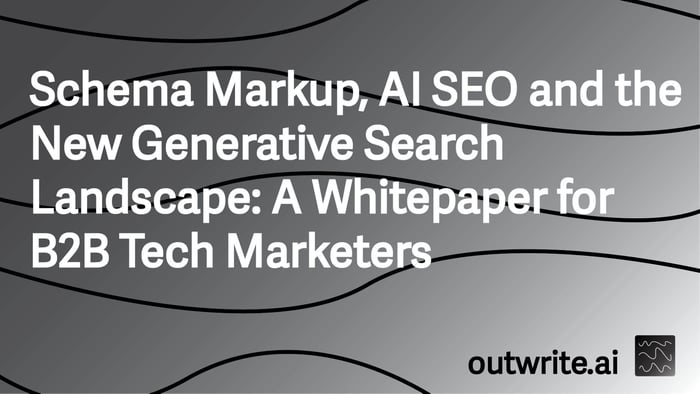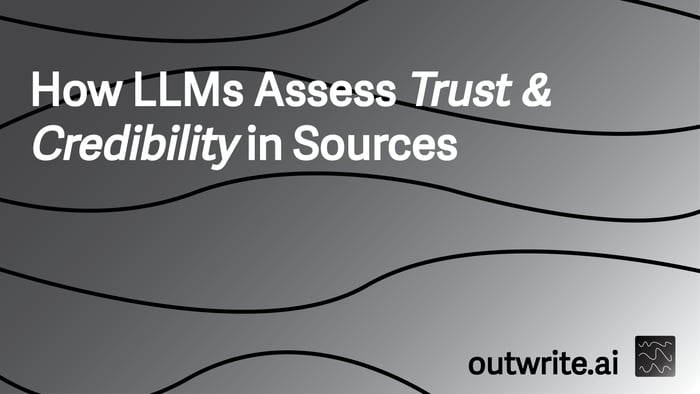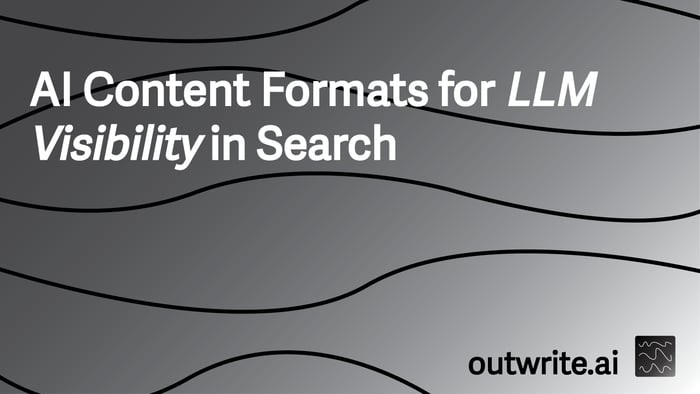Table of Contents
- The Inevitable Shift: AI vs. Google
- Understanding the Current Landscape
- The Driving Forces Behind AI Growth
- Impact on Traditional SEO and Publishers
- Adapting Your Strategy for AI Visibility
- Case Studies and Real-World Applications
- The Future of AI Search and Discovery
- Preparing for the AI-First Era
- Frequently Asked Questions (FAQ)
- Conclusion
Hey there! Have you ever stopped to think about how you'll find information online in just a few years? It's a question that's becoming increasingly relevant as AI technology rapidly evolves. We're on the cusp of a monumental shift, one where AI traffic isn't just a niche trend but a dominant force, poised to eclipse even Google's long-standing reign by 2029. This isn't just a bold prediction; it's a trajectory supported by compelling data and expert insights.
This article will dive deep into the future of search, exploring the current state of AI traffic versus traditional search, the underlying factors fueling AI's explosive growth, and the profound implications for businesses, publishers, and everyday users. We'll unpack why companies absolutely need to start focusing on AI visibility now, offering practical strategies and real-world examples to help you navigate this transformative digital landscape. Get ready to discover how AI technology is reshaping how we interact with the internet.
The Inevitable Shift: AI vs. Google
The digital world is constantly evolving, and the next big wave is undeniably AI technology. For decades, Google has been the undisputed king of information retrieval, guiding billions of users to their desired content. However, a new challenger has emerged, and it's growing at an unprecedented rate: AI-driven traffic. Experts are now forecasting that by 2029, the volume of traffic generated by AI platforms could surpass that of traditional search engines like Google. This isn't a minor adjustment; it's a fundamental reordering of the digital ecosystem.
This shift isn't merely about new tools; it's about a paradigm change in how users discover and consume information. Instead of typing keywords into a search bar and sifting through blue links, users are increasingly turning to conversational AI assistants for direct, synthesized answers. This preference for immediate, curated responses is a powerful driver behind the projected dominance of AI traffic. It represents a move from a "search and click" model to an "ask and receive" model, fundamentally altering user behavior and expectations.
The implications for businesses and content creators are immense. If your digital strategy is solely focused on optimizing for Google's traditional algorithms, you might be missing out on a rapidly expanding audience. Understanding this impending shift is the first step toward future-proofing your online presence. It requires a proactive approach to integrating AI technology trends into your digital marketing and content creation efforts.
Why is this shift so critical for companies to acknowledge and act upon? Because visibility in the AI-first world will be determined by different metrics and optimization strategies. Companies that fail to adapt risk becoming invisible in the very channels where their target audience will be seeking information. It’s about securing your future relevance in a digitally transformed landscape.
What are the core reasons for this predicted shift?
- User Preference for Direct Answers: Modern users often prefer concise, direct answers provided by AI over sifting through multiple search results. This saves time and provides immediate gratification.
- Advancements in Natural Language Processing (NLP): AI's ability to understand complex queries and provide human-like responses has dramatically improved, making interactions more intuitive and effective.
- Integration into Everyday Devices: AI assistants are now embedded in smartphones, smart speakers, and various applications, making them easily accessible and a natural part of daily routines.
- Personalization and Contextual Understanding: AI can offer highly personalized results based on user history, preferences, and real-time context, leading to more relevant and satisfying experiences.
Understanding the Current Landscape
To truly grasp the magnitude of the predicted shift, we need to examine the current state of play between AI traffic and traditional search. While AI's growth is undeniable, Google still holds a commanding lead in overall internet traffic. However, the trajectory of AI technology indicates a rapid closing of this gap. Let's break down the numbers and see where we stand today.
As of 2025, AI traffic constitutes a relatively small fraction of global internet traffic, accounting for approximately 0.15%. This might seem insignificant when compared to the 48.5% dominated by organic search, primarily Google. This means Google currently sends roughly 300 times more traffic than all AI platforms combined. However, this snapshot doesn't tell the whole story. The growth rate of AI traffic is nothing short of explosive, having jumped more than 7x from 0.02% in 2024 to 0.15% in 2025, according to SE Ranking's research.
Looking specifically at AI chatbots, the numbers are even more striking. Between April 2024 and March 2025, AI chatbots experienced an 80.92% year-over-year growth in visits, accumulating a staggering 55.2 billion visits. In stark contrast, traditional search engines like Google and Bing saw a slight 0.51% decrease YoY, though they still commanded 1.86 trillion visits in the same period. This divergence in growth rates is the core indicator of the impending shift.
While Google's dominance is still substantial, its global search market share has dipped below 90% in 2025, hovering in the high 89% range. This marks the first time since 2015 that Google's share has fallen below this threshold, reflecting the emerging competition from AI-native tools like ChatGPT and Perplexity. The data clearly illustrates a market in transition, where AI technology solutions are rapidly gaining traction and reshaping user behavior.
| Metric | Value | Source(s) | Significance |
|---|---|---|---|
| AI Traffic % of Internet | 0.15% in 2025 (up 7x from 2024) | SE Ranking | Rapid growth despite small current share. |
| Organic Search Traffic % | 48.5% in 2025 | SE Ranking | Google's current dominance. |
| AI Chatbot Visits (12 mo) | 55.2 billion (Apr 24 - Mar 25) | Chillibyte | Explosive growth in AI chatbot usage. |
| Search Engine Visits (12 mo) | 1.86 trillion (Apr 24 - Mar 25) | Chillibyte | Still massive, but growth is stagnant. |
| Google Search Market Share | ~89% (below 90% in 2025) | ContentGrip | First significant dip in a decade. |
| AI Search Traffic Share (Aug 2025) | 8.2% | Wix AI Search Lab | Growing share within overall search. |
The Driving Forces Behind AI Growth
The rapid ascent of AI traffic isn't accidental; it's the result of several powerful technological advancements and shifts in user behavior. Understanding these driving forces is crucial for any business looking to implement effective AI technology strategies and solutions. These factors collectively create a compelling case for the future dominance of AI in information retrieval.
One of the primary drivers is the exponential improvement in Large Language Models (LLMs). These sophisticated AI models, like those powering ChatGPT and Google Gemini, can process and understand human language with unprecedented accuracy. This allows them to provide highly relevant, coherent, and conversational responses to complex queries, far beyond the capabilities of traditional keyword-based search engines. The ability of these models to synthesize information from vast datasets and present it in an easily digestible format is a game-changer for user experience.
Another significant factor is the increasing integration of AI into everyday digital interfaces. From voice assistants in smart homes to AI-powered chatbots on websites and mobile apps, AI technology is becoming ubiquitous. This seamless integration makes AI tools more accessible and convenient for users, naturally drawing more traffic away from traditional search methods. The more effortlessly users can interact with AI, the more they will rely on it for their information needs.
Furthermore, the personalized nature of AI interactions plays a crucial role. AI systems can learn from user preferences, past queries, and contextual data to deliver highly tailored results. This level of personalization often leads to a more satisfying and efficient information-seeking experience compared to generic search results. The continuous feedback loop between user interaction and AI learning further refines these systems, making them even more indispensable over time.
What makes AI traffic grow so fast?
- Superior User Experience: AI offers direct, conversational answers, eliminating the need to click through multiple links. This efficiency and ease of use are highly attractive to users.
- Advanced LLM Capabilities: Models like ChatGPT and Gemini can understand nuance, context, and complex intent, providing more accurate and comprehensive answers than traditional search.
- Ubiquitous Integration: AI is embedded in various platforms, from search engines (like Google's SGE) to dedicated chatbots and virtual assistants, making it easily accessible.
- Personalization: AI adapts to individual user preferences and historical data, delivering highly relevant and tailored information, fostering greater user loyalty.
Impact on Traditional SEO and Publishers
The rise of AI traffic isn't just a shift in how users find information; it's a seismic event for traditional SEO and the publishing industry. For years, SEO strategies have revolved around optimizing for Google's algorithms, aiming for high rankings and organic click-throughs. However, the advent of AI search fundamentally alters this landscape, presenting both challenges and new opportunities for AI technology best practices.
One of the most significant impacts is the phenomenon of "no-click searches." When an AI assistant provides a direct, synthesized answer, users often don't need to click through to the original source. This can lead to a substantial reduction in referral traffic for publishers and websites that have historically relied on organic search. According to Similarweb, the rise of AI search has already caused a 15% drop in global search traffic in the past year, severely impacting publishers. This means that even if your content is the source for an AI's answer, you might not receive the direct traffic you once did.
This shift necessitates a re-evaluation of traditional SEO metrics and goals. While ranking high on Google's SERP remains important, visibility within AI answers becomes equally, if not more, crucial. Publishers and businesses need to consider how their content is being ingested and summarized by AI models, and how they can ensure their brand and expertise are still recognized, even in a no-click environment. The Independent Publishers Alliance has even filed an antitrust complaint against Google, highlighting industry concern over AI Overviews reducing publisher traffic and revenue since May 2024.
The challenge for companies is to adapt their content strategies to be "AI-ingestible" and to explore new ways to derive value from their content, even if it doesn't always result in direct website traffic. This could involve focusing on brand authority, thought leadership, and innovative ways to engage users directly within AI interfaces. The future of digital visibility hinges on mastering these new AI technology trends.
How AI search impacts traditional SEO:
- Reduced Click-Through Rates: AI's ability to provide direct answers means fewer users click on traditional search results, impacting organic traffic.
- Emphasis on Featured Snippets and Direct Answers: Content optimized for these formats becomes critical, as AI often pulls information from them.
- Shift from Keywords to Conversational Queries: SEO needs to adapt to natural language processing and long-tail, conversational queries.
- New Metrics for Success: Beyond clicks, brand mentions in AI summaries and direct integrations with AI platforms will become important.
- Content Quality and Authority: AI prioritizes high-quality, authoritative, and well-structured content for its responses, making expertise paramount.
Adapting Your Strategy for AI Visibility
Given the imminent shift towards AI-dominated traffic, companies must proactively adapt their digital strategies. Simply continuing with traditional SEO tactics won't suffice. The focus needs to broaden to encompass AI technology solutions that ensure visibility and relevance in an AI-first world. This means rethinking content creation, optimization, and engagement models.
One of the most critical adjustments is optimizing your content for AI ingestion. AI models thrive on structured, clear, and authoritative information. This involves creating content that is easily parsable, with distinct headings, bullet points, and concise answers to common questions. Think about how an AI would summarize your content; is it easy for it to extract key facts and present them coherently? This approach aligns with AI technology best practices for content structuring.
Furthermore, businesses should explore direct engagement with AI platforms. This could mean leveraging APIs to feed your data directly into AI models, participating in AI-driven content programs, or even developing your own AI assistants that draw upon your proprietary information. The goal is to ensure your content is not just discoverable by AI, but actively integrated into the AI's knowledge base, making it a primary source for answers. This proactive integration is a cornerstone of effective AI technology strategies.
Finally, monitoring AI traffic trends is paramount. Platforms like Similarweb offer insights into how AI is referring traffic and where user attention is shifting. By closely tracking these trends, companies can adjust their marketing and SEO budgets to prioritize AI platforms as they grow, rather than solely focusing on traditional Google Search channels. This agile approach to resource allocation will be key to maintaining competitive advantage in the evolving digital landscape.
Key strategies for AI visibility:
- Structured Content Creation: Develop content with clear headings, bullet points, and concise answers to facilitate AI ingestion and summarization.
- Semantic SEO: Focus on topic clusters and semantic relationships rather than just individual keywords, helping AI understand the broader context of your content.
- Direct AI Integration: Explore partnerships, APIs, and direct data feeds to ensure your content is a primary source for AI models.
- Voice Search Optimization: Optimize for conversational queries and natural language patterns, as voice search is a major interface for AI.
- Build Brand Authority: Establish your brand as a trusted, authoritative source, as AI models often prioritize reputable information.
- Monitor AI Analytics: Track how AI platforms are interacting with and referring to your content to refine your strategies.
Case Studies and Real-World Applications
The theoretical shift towards AI traffic is already manifesting in real-world scenarios, offering valuable insights into how AI technology is being implemented and its immediate effects. Examining these case studies helps us understand the practical implications and successful AI technology solutions in action. These examples highlight the urgency for businesses to adapt their strategies.
Consider Google's own response to the AI challenge: Bard and the Search Generative Experience (SGE). These hybrid AI search integrations blur the line between traditional and AI search, offering AI-generated summaries directly within the search results page. While traditional Google Search still commands substantial query volume, SGE represents Google's acknowledgment of the changing user preference for direct answers. This move demonstrates that even the search giant is evolving its core product to incorporate AI-first principles, validating the broader industry trend.
ChatGPT, despite being a relatively new player, has already demonstrated its immense potential. It generated approximately 4 billion monthly visits in mid-2025, a remarkable feat for a non-traditional search interface. While this is still dwarfed by Google's 136 billion monthly visits, the sustained double-digit growth of platforms like ChatGPT is the key indicator that AI is on track to overtake traditional search traffic. Companies are already seeing the benefits of optimizing for these platforms, gaining visibility within AI-generated responses.
Beyond search, AI's ability to leverage vast big data and real-time user input is exemplified by services like Google Maps. The "Brain Behind The Map" article highlights how AI and traffic prediction in Google Maps demonstrate the power of continuous data refinement and machine learning adaptation for accurate predictive services. This model of real-time, user-generated data feeding into AI for enhanced accuracy and engagement is a blueprint for how other industries can leverage AI to provide superior user experiences and drive traffic.
Examples of AI technology in action:
- Google's SGE and Bard: Google's integration of AI-generated summaries directly into search results, providing direct answers and reducing the need for clicks.
- ChatGPT's Rapid Growth: Achieving billions of monthly visits by offering conversational, synthesized information, demonstrating user preference for AI.
- Perplexity AI: A search engine built entirely around AI, providing sourced answers directly, challenging traditional search models.
- Google Maps Traffic Prediction: Uses AI to analyze real-time user data for highly accurate traffic forecasts, showcasing AI's predictive power.
The Future of AI Search and Discovery
Looking beyond 2029, the future of AI search and discovery promises an even more integrated, personalized, and efficient information landscape. The current AI technology trends are merely the beginning of a profound transformation that will redefine how we interact with digital information. This evolution will have far-reaching implications for businesses, requiring continuous adaptation and innovation.
One key aspect of this future is the increasing sophistication of AI in understanding complex, multi-modal queries. Imagine asking an AI assistant to plan a multi-day trip, considering your budget, preferences, and real-time conditions, and having it not only provide a detailed itinerary but also book flights and accommodations. This level of comprehensive, proactive assistance goes far beyond what traditional search engines can offer, making AI an indispensable personal agent for information and task completion.
Furthermore, the integration of AI will extend deeper into our physical environments through augmented reality (AR) and ubiquitous computing. We might ask an AI about a product in a store, and it instantly provides reviews, price comparisons, and nutritional information, overlaid directly onto our view. This seamless blend of digital information with the physical world will make AI the primary gateway to knowledge, rendering traditional search less relevant for many everyday tasks. This represents a significant evolution in AI technology solutions.
For businesses, this future means moving beyond simply being "found" to being "integrated" and "proactive." Your products and services will need to be discoverable and actionable within AI ecosystems. This could involve developing AI-friendly product descriptions, integrating with AI commerce platforms, or even creating branded AI assistants. The companies that embrace these AI technology strategies will be best positioned to thrive in the AI-first era.
What will AI search look like in the future?
- Proactive Information Delivery: AI will anticipate your needs and deliver relevant information before you even ask, based on context and past behavior.
- Multi-Modal Interactions: Users will interact with AI using voice, text, images, and even gestures, leading to richer and more natural experiences.
- Deep Personalization: AI will act as a highly intelligent personal assistant, tailoring information and services to individual preferences, habits, and real-time situations.
- Seamless Integration with the Physical World: Through AR and IoT, AI will provide contextual information about objects and environments around us, making information omnipresent.
- Autonomous Agents: AI will be capable of completing complex tasks on your behalf, from booking appointments to managing finances, based on your instructions and preferences.
Preparing for the AI-First Era
The transition to an AI-first digital landscape isn't a distant fantasy; it's a rapidly approaching reality. For businesses, preparing for this era means more than just minor adjustments; it requires a fundamental shift in mindset and a proactive adoption of AI technology best practices. Companies that start now will gain a significant competitive advantage, while those that delay risk being left behind.
One of the most crucial steps is to invest in understanding how AI models consume and interpret information. This involves auditing your existing content for clarity, structure, and factual accuracy. Are your key messages easily extractable by an AI? Is your data presented in a way that can be readily synthesized? This foundational work is essential for ensuring your content is "AI-readable" and can serve as a reliable source for AI-generated answers. This is a core component of any robust AI technology guide.
Furthermore, cultivating strong brand authority and trustworthiness will become even more critical. AI models are designed to prioritize authoritative sources to prevent the spread of misinformation. By building a reputation as a reliable and expert voice in your industry, you increase the likelihood that AI will reference your content and recommend your brand. This isn't just about SEO anymore; it's about establishing digital credibility in an era where AI acts as a gatekeeper of information.
Finally, fostering a culture of continuous learning and experimentation within your organization is vital. The field of AI is evolving at an incredible pace, and what works today might be obsolete tomorrow. Encourage your teams to stay updated on the latest AI technology trends, experiment with new tools and platforms, and be agile in adapting your strategies. This proactive and flexible approach will be the hallmark of successful businesses in the AI-first era.
Actionable steps for businesses:
- Content Audit and Restructuring: Review existing content for AI readability, ensuring clear headings, concise answers, and structured data.
- Semantic Optimization: Shift from keyword-centric SEO to topic authority and comprehensive coverage, making your content a go-to source for AI.
- AI Platform Engagement: Actively explore partnerships, API integrations, and direct content feeds with leading AI platforms.
- Voice Search & Conversational UI: Optimize for natural language queries and design user experiences that are intuitive for conversational AI.
- Data-Driven Decision Making: Utilize AI traffic analytics to understand user behavior and refine your content and marketing strategies.
- Brand Trust & Authority: Focus on building a strong, credible brand reputation, as AI prioritizes authoritative sources.
- Employee Training: Educate your teams on AI trends, tools, and best practices to foster an AI-ready workforce.
Frequently Asked Questions (FAQ)
How do I optimize my website for AI search engines?
To optimize for AI search, focus on creating highly structured, clear, and authoritative content that answers user questions directly. Use semantic HTML, clear headings, and concise paragraphs to make your content easily digestible for AI models. This enhances your chances of being featured in AI-generated summaries.
- Structured Data: Implement Schema.org markup to provide explicit semantic meaning to your content, making it easier for AI to understand.
- Direct Answers: Phrase content to directly answer common questions, similar to how you'd answer a person in conversation.
- Topic Authority: Develop comprehensive content around specific topics to establish your site as an authoritative source.
- Natural Language: Write in a natural, conversational tone that aligns with how users interact with AI assistants.
What are the main differences between AI search and traditional Google search?
AI search provides direct, synthesized answers in a conversational format, often without requiring a click to an external website. Traditional Google search, conversely, presents a list of links that users must click through to find information. AI focuses on understanding complex intent and providing a single, comprehensive response.
- Output Format: AI delivers summarized, direct answers; traditional search provides a list of links.
- Interaction Style: AI is conversational and interactive; traditional search is query-and-click based.
- Information Synthesis: AI synthesizes information from multiple sources; traditional search points to individual sources.
- Personalization: AI offers deeper, context-aware personalization; traditional search is less dynamic in its personalization.
Why should my company prioritize AI visibility now?
Your company should prioritize AI visibility now because AI traffic is growing exponentially and is projected to eclipse traditional search by 2029. Early adoption ensures your brand remains discoverable and relevant in the evolving digital landscape, securing future market share and user engagement.
- Future-Proofing: Adapting early ensures your business remains competitive as user behavior shifts.
- First-Mover Advantage: Gaining visibility on emerging AI platforms can establish your brand as a leader.
- Increased Reach: Tapping into new user segments who prefer AI-driven information retrieval.
- Brand Authority: Being a recognized source for AI answers enhances your credibility and trust.
When will AI traffic truly surpass Google's traditional search traffic?
Industry experts and analysts predict that AI-powered search traffic will eclipse Google’s traditional search traffic by around 2029–2030. This forecast is based on the rapid growth rates of AI platforms and a gradual decline in traditional query-and-click search usage.
What is the current market share of major AI chatbots?
Currently, ChatGPT leads with about 77.97%–86.32% share of the AI chatbot market. Google Gemini follows with around 6.4% to ~13%, while Perplexity holds 15.1% in specific AI chatbot markets. Other platforms like Claude and DeepSeek hold minimal shares.
How does AI search impact website referral traffic for publishers?
AI search can significantly reduce website referral traffic for publishers because it often provides summarized answers directly, leading to "no-click searches." This has already caused a 15% drop in global search traffic, impacting revenue for content creators reliant on organic clicks.
What role does natural language processing (NLP) play in AI search?
NLP is fundamental to AI search, enabling AI models to understand, interpret, and generate human language. It allows AI to grasp the nuances of complex queries, extract relevant information from vast datasets, and formulate coherent, human-like responses, making conversational search possible and effective.
Can small businesses compete with larger companies in AI search visibility?
Yes, small businesses can compete by focusing on niche expertise and creating highly authoritative, structured content within their specific domain. AI prioritizes quality and relevance, so a small business excelling in a particular area can become a go-to source for AI, regardless of its size.
How will AI search affect local SEO?
AI search will enhance local SEO by providing more personalized and context-aware recommendations. Optimizing Google Business Profile, ensuring consistent NAP (Name, Address, Phone) information, and generating local reviews will be even more crucial, as AI will leverage this data for hyper-local answers.
What are the ethical considerations for AI in search?
Ethical considerations for AI in search include bias in algorithms, data privacy, the potential for misinformation, and transparency in how AI generates answers. Ensuring fairness, accountability, and user control over data are critical challenges that need to be addressed as AI search evolves.
Should I stop optimizing for Google's traditional search?
No, you shouldn't stop optimizing for Google's traditional search entirely. Google still commands a massive share of internet traffic. Instead, you should integrate AI optimization into your existing SEO strategy, creating a hybrid approach that addresses both traditional search and emerging AI platforms to maximize your overall digital visibility.
How can I measure my website's AI traffic?
Measuring AI traffic can be challenging as direct referrals are often limited. However, you can use tools like Similarweb to track AI-referred sessions and monitor your content's appearance in AI-generated summaries. Analyzing changes in direct traffic and brand mentions can also provide indirect insights into your AI visibility.
What is "AI-ingestible" content?
"AI-ingestible" content is designed to be easily understood and processed by AI models. It features clear, concise language, well-defined headings, bulleted lists, and often uses structured data (Schema.org) to explicitly label information. This format allows AI to quickly extract key facts and synthesize accurate answers.
Will AI search lead to a "traffic apocalypse" for all websites?
While some publishers have experienced a decline in referral traffic due to AI's direct answers, it won't necessarily be an apocalypse for all. Websites that adapt by creating high-quality, AI-optimized content, building strong brand authority, and exploring direct AI integrations can maintain or even increase their overall visibility and influence.
How can I stay updated on the latest AI search trends?
To stay updated, regularly follow industry publications like Search Engine Land, SE Ranking, and ContentGrip. Attend webinars, subscribe to newsletters from AI research labs, and engage with AI communities. Experimenting with new AI tools and platforms yourself is also an excellent way to gain firsthand insights into emerging trends.
Conclusion
The digital landscape is on the brink of a monumental transformation, with AI technology poised to eclipse Google's traditional search dominance by 2029. This isn't just a prediction; it's a trajectory supported by explosive growth in AI traffic, evolving user preferences for direct answers, and the continuous advancement of large language models. The data clearly indicates a market in transition, where AI is rapidly reshaping how users discover and consume information.
For businesses, this shift is a clarion call to action. Companies that fail to prioritize AI visibility risk becoming invisible in the very channels where their target audience will be seeking information. Adapting your strategy now, by optimizing content for AI ingestion, exploring direct AI integrations, and fostering brand authority, is not merely an option but a necessity for future relevance and competitive advantage. The future of digital success hinges on embracing these AI technology strategies.
The AI-first era demands a proactive, agile, and innovative approach. By understanding the driving forces behind AI's growth, acknowledging its impact on traditional SEO, and implementing effective AI technology solutions, your organization can not only navigate this change but thrive within it. The time to prepare for this inevitable shift is now, ensuring your place at the forefront of the digital future.
Authored by Aidan Buckley, Subject matter expert at outwrite.ai.





